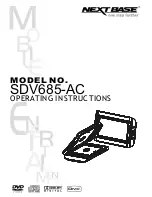
CDJ-1000MK2
70
1
2
3
4
1
2
3
4
C
D
F
A
B
E
Methods for assigning an address in a search operation
There are six methods for assigning an address in a search operation, as follows.
(Address Block) *
With the BK command, the address mode is set to block (absolute time = AMIN:ASEC:AFRAME).
Example: To search for 2 min 3 sec 4 frame: BK20304SE
(Address Track) *
With the TR command, the address mode is set to track.
Example: To search for the fifth piece of music (5th track): TR5SE
(Address Index) *
With the IX command, the address mode is set to index (TNO:INDEX).
Example: To search for Index 3 of the second piece of music: IX203SE
(Address Time) *
With the TM command, the address mode is set to time (absolute time = AMIN:ASEC)
Example: To search for 2 min 3 sec: TM203SE
* Once one of these address modes is assigned, it is maintained until another address mode is assigned.
(Error Count)
The error rate from the current location to the assigned address is calculated.
Example: To calculate the error rate from 20 min 0 sec 0 frame to 21 min 0 sec 0 frame and show the result
BK200000SE210000EC?E
Note:
Figures in parentheses indicate the number of uncorrectable errors.
(TOC Information Request)
The TOC information for the disc is displayed.
Example: If the TOC information is 0116704307:
Number of the starting track = 01, number of the ending track = 16, recorded time = 70:43:07
To manually start a servo
You can control the servo operations manually. Care must be taken during a manual operation in Test mode, because an
inappropriate operation may damage the player.
For manual starting, the commands must be executed in the following order:
1TM : For turning on the laser diode
9TM : For judging if a disc is inside
3TM : For turning on the spindle
9TM : For disc search
2TM : For turning on the focus servo
13TM : For the tracking balance adjustment
4TM : For turning on the tracking servo
12TM : For the focus-position adjustment
15TM : For the focus-gain adjustment
16TM : For the tracking-gain adjustment
6TM : To start reading the address
(Single Jump Fwd/Rev)
To jump by one track (physical track, not one piece of music) toward the outermost/innermost track of the disc
(Multi Jump Fwd/Rev)
To jump by a given number of tracks (physical track, not pieces of music) toward the outermost/innermost track of the disc
Example: To jump by 100 tracks from the current location toward the outermost track: 100MF
(Slider Move Fwd/Rev)
To move the slider by about 1 mm toward the outermost/innermost track of the disc. You can move the slider to your desired
location by repeatedly executing this command.
















































